Coconut trees provide a sustainable source of income for millions of Filipino farmers. Coconut farming plays a crucial role in rural development by providing employment opportunities and improving infrastructure in remote areas where these plantations thrive. Coconut cultivation in the Philippines is a thriving industry important to the country’s economy.
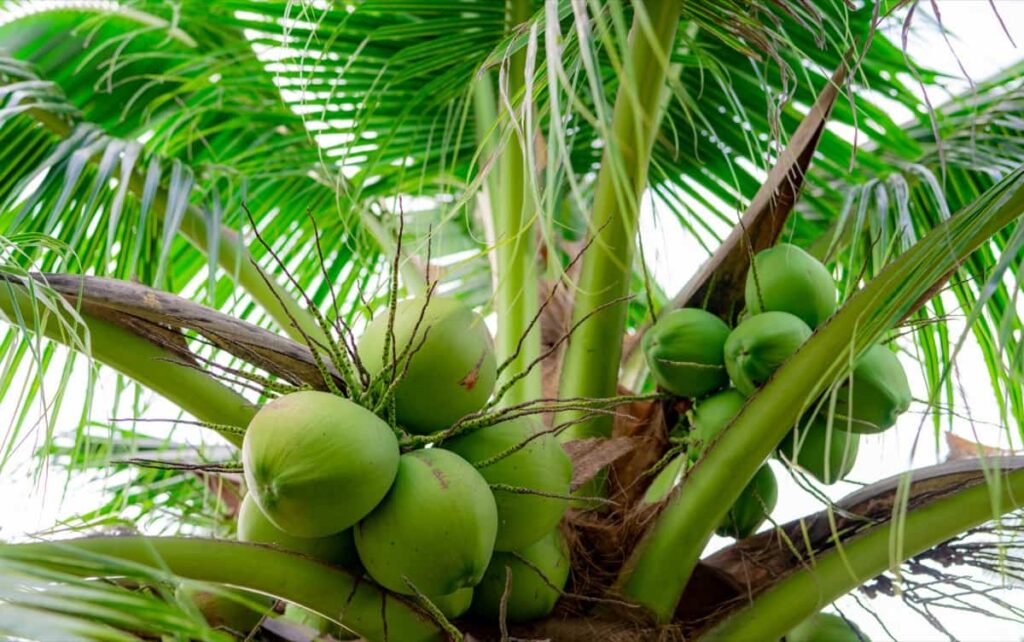
Coconut Farming in the Philippines
History of Coconut in the Philippines
Coconut is recognized as one of the most important crops in the Philippines. Producing about 347 million metric tons of fruit annually, the country is among the top producers of Coconuts in the world. Farmers produce enough for the country to hold about 45% of world Coconut exports. The industry dominates most of the country’s agriculture sector. The Coconut industry employs approximately 3.4 million Coconut farmers.
Coconut farming holds immense importance in the Philippines, contributing significantly to the country’s economy and the livelihoods of millions of farmers. In modern times, Coconut farming remains one of the most important agricultural industries in the Philippines. The country is among the world’s top producers and exporters of Coconut products like oil, milk, water, and desiccated Coconut. The resilience of Coconuts against typhoons makes them particularly well-suited for cultivation in this tropical nation.
Varieties of Coconuts Grown in the Philippines
- Tall – Baybay, San Ramon, Tagnanan, Laguna, Agta, Macapuno,
- Dwarf – Catigan, Coconino, Kinabalan, Pilipog, Tacunan, Mangipod, and Tampakan
Dwarf-variety Coconuts are known for their compact size and shorter height than their taller counterparts. The dwarf variety thrives best in areas with well-drained soil and plenty of sunlight. Tall Coconuts require deep soil with good drainage for optimal growth. They can tolerate slightly more shade than dwarf Coconuts but still need ample sunlight to flourish. Both varieties play a significant role in Coconut farming throughout the country. The choice between them depends on factors like climate conditions and market demand.
In case you missed it: 20 Best Dwarf Coconut Varieties: Hybrid High Yielding Coconut Cultivars
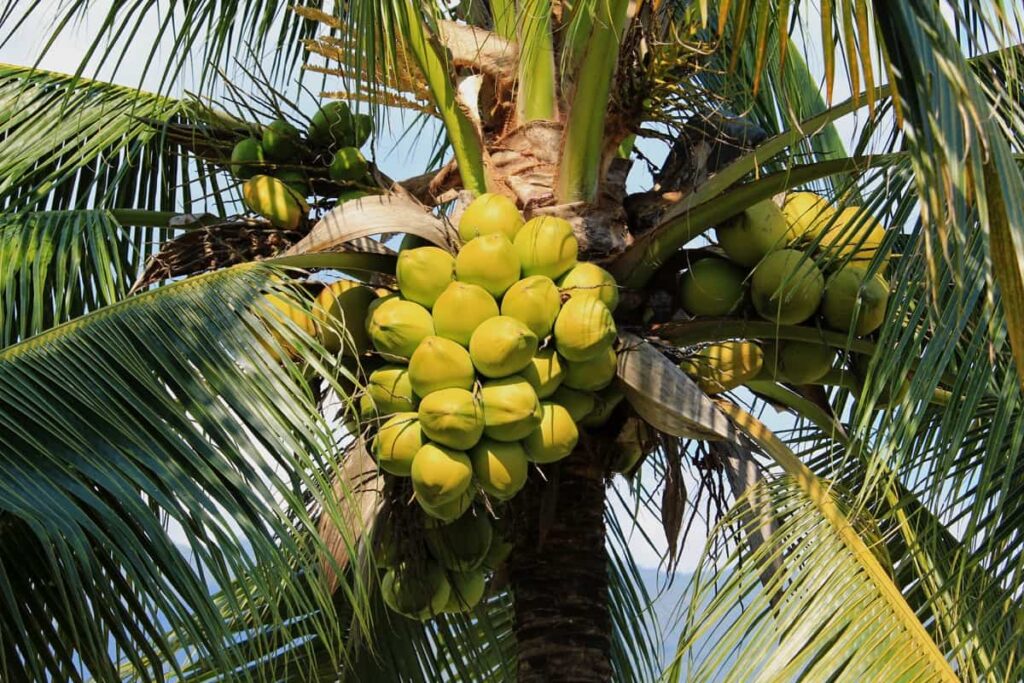
Step-by-step Guide to Coconut Farming in the in the Philippines
Planting and Propagation Techniques for Coconut Trees in the Philippines
Coconuts thrive in tropical climates, making the Philippines an ideal location for cultivation. The country’s warm temperatures, ranging from 24°C to 35°C throughout the year, create optimal conditions for Coconut trees to grow. The main Coconut propagation method is through seed germination, where mature Coconuts are selected and soaked in water for several days to soften the husk.
Once softened, the husk is carefully removed to reveal the inner shell. The shell is then cracked open to extract the embryo or sprout. To promote healthy growth, selecting high-quality seeds with well-developed embryos is important. These seeds should be planted immediately after extraction to prevent drying out. They are typically planted at a 2-3 inches depth in well-drained soil enriched with organic matter.
Coconut trees require ample sunlight and space for their sprawling branches. Therefore, spacing between each tree should be around 8-10 meters apart to allow sufficient airflow and light penetration. In addition to seed germination, another popular Coconut propagation method is planting young Coconut seedlings or “Coconut saplings.”
These saplings can be purchased from reputable nurseries that specialize in Coconut farming. Planting techniques in Coconut may vary depending on location and soil conditions but generally involve digging a hole slightly larger than the sapling’s root ball. The roots are carefully spread out within the hole before backfilling with soil, ensuring that no air pockets remain.
Nutrient Management for Coconut Crops in the Philippines
By conducting regular soil tests, farmers can determine the specific nutrient requirements of their Coconut plantations. This allows them to apply fertilizers that are tailored to meet those needs. Phosphorus and potassium are two crucial nutrients for Coconut trees. Phosphorus aids in root development and flowering, while potassium promotes growth and disease resistance.
Organic matter also plays an important role in maintaining soil fertility. Coconut husks, leaves, or composted organic materials can be used as mulch or incorporated into the soil to improve its structure and moisture retention capacity. In addition to macro-nutrients like nitrogen, phosphorus, and potassium, micronutrients such as iron, zinc, and manganese are equally important for optimal Coconut tree growth.
Pest and Disease Management in Coconut Farming in the Philippines
With its tropical climate, the Coconut is affected by different pests and diseases that can significantly impact its growth. Farmers must proactively identify and address these issues to ensure healthy and productive plantations. The main pest that affects Coconut trees is the rhinoceros beetle.
In case you missed it: Optimizing Coconut Orchard Operations: A Comprehensive Management Guide for Month-wise Planning
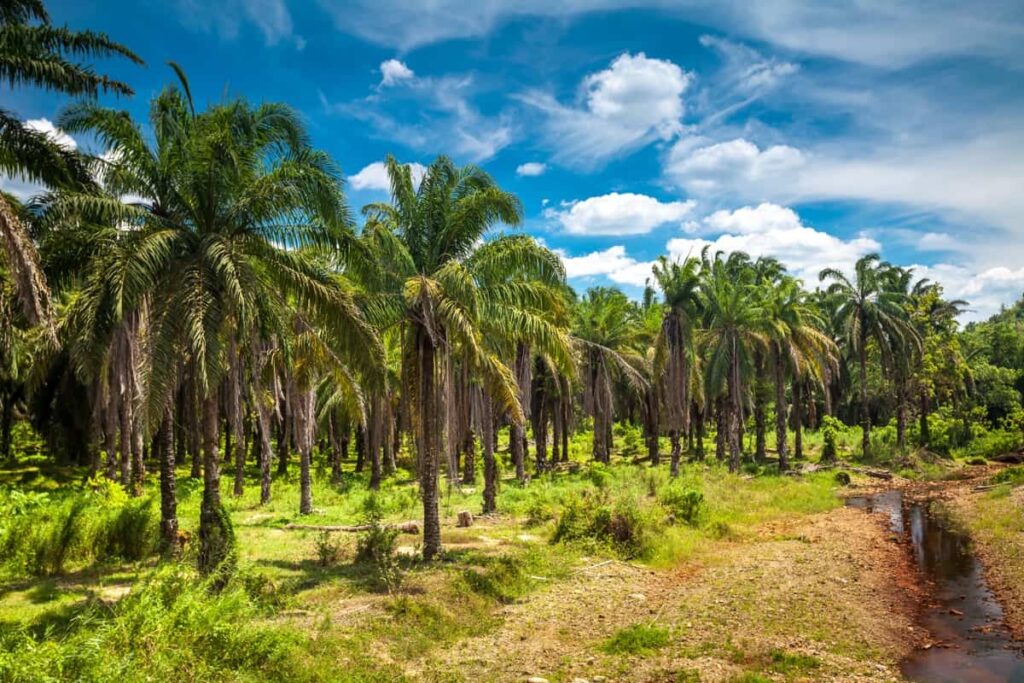
These large insects have a voracious appetite for Coconut leaves, causing significant damage if left unchecked. Farmers often employ trapping techniques using pheromone-laced traps or biological control methods with natural predators like weaver ants to control their population. Another challenge faced by Coconut farmers in the Philippines is the dreaded lethal yellowing disease (LYD).
This devastating disease attacks the palm’s vascular system, leading to rapid decline and death of infected trees. Early detection through regular monitoring is essential to prevent its spread within plantations. Quarantine measures may also be necessary to contain outbreaks. Proper sanitation practices are crucial to combat diseases like bud rot or root wilt caused by fungal pathogens. Integrated pest management (IPM) strategies are commonly employed in Coconut farms as a holistic pest and disease control approach.
Irrigation and Water Management for Coconut Plantations in the Philippines
Coconut trees require regular watering, especially during their initial years. Adequate moisture is essential for establishing young plants and promotes healthy root development. Drip irrigation systems are commonly used in Coconut farming, delivering water directly to the roots while minimizing wastage. In addition to providing sufficient water, it’s important to manage irrigation schedules effectively. Overwatering can lead to stagnant conditions, increasing the risk of diseases such as root rot. On the other hand, under-watering can cause stress and reduce yield potential.
Pruning and Training Practices for Coconut Trees in the Philippines
The important aspect of pruning is removing dead or diseased branches from the tree. This not only improves the overall appearance but also prevents the spread of diseases. It is recommended to remove these fronds regularly to maintain tree health. In terms of training, it is essential to shape young Coconut trees by tying them to stakes for support until they establish strong roots.
This ensures that they grow straight and upright, maximizing their exposure to sunlight. Furthermore, some farmers practice de-husking, removing excess leaves near the base of mature trees. This allows easier access for picking Coconuts during harvesting.
Harvesting and Post-Harvest Handling of Coconuts in the Philippines
Harvesting Coconuts is a crucial step that requires careful timing to ensure optimal quality. The ideal time to harvest Coconuts is when they are about 10-12 months old. The nuts are mature enough for consumption and have a higher oil content. To harvest Coconuts, farmers use long poles with sharp blades attached to them. These blades are used to cut off ripe Coconuts from the tree. It’s important to be cautious during this process, as falling Coconuts can cause injury.
In case you missed it: Eco-friendly Strategies: Sustainable Management of Coconut Pests
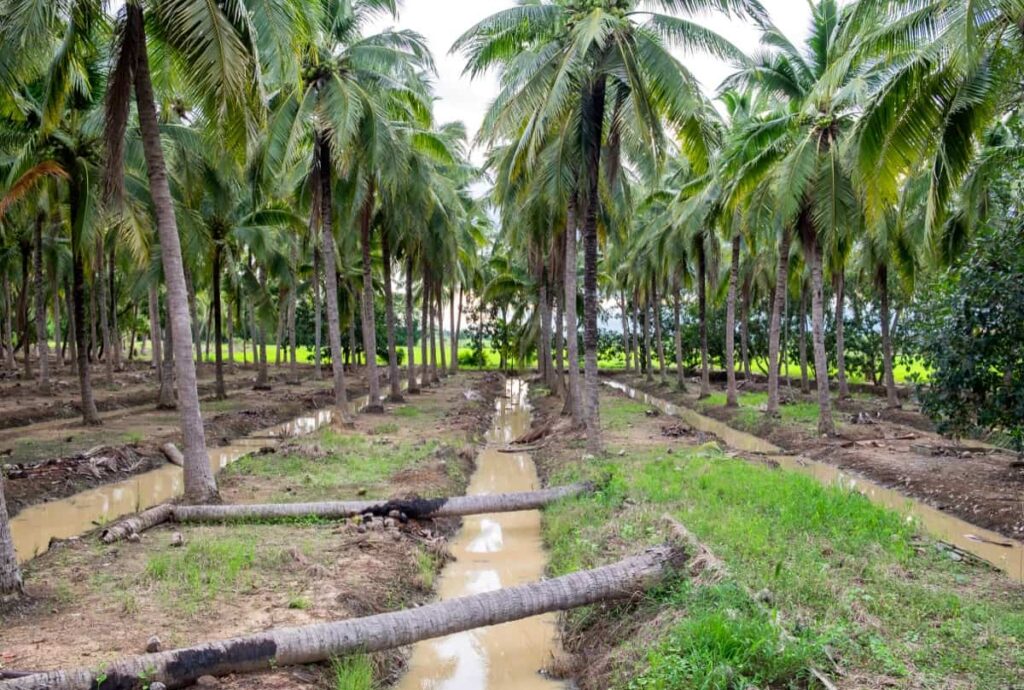
Once harvested, it’s essential to handle the Coconuts carefully to maintain their quality. They should be stored in a cool, dry place away from direct sunlight. Proper ventilation is also crucial to prevent mold growth. In terms of post-harvest processing, different methods depend on whether you’re aiming for copra production or fresh consumption. Coconut farming presents numerous opportunities for profit generation in the Philippines.
Coconut Yield per hectare in the Philippines
In the Philippines, traditional Coconut varieties have the potential to produce about 15,000 nuts per year on just one hectare of land. Every aspect of Coconut farming is crucial in maximizing productivity, from ensuring proper irrigation and fertilization techniques to protecting against pests and diseases.
Moreover, it’s essential to note that while traditional varieties offer substantial yields, modern cultivation practices are constantly evolving. Farmers can now access improved hybrid varieties that promise even higher production rates. These advancements increase profitability and contribute toward meeting global demand for Coconuts.
Government Policies and Support for Coconut Farmers in the Philippines
The Coconut industry plays a vital role in providing employment opportunities, especially in rural areas where agriculture is the main source of income. The government of the Philippines recognizes the importance of Coconut farming as a vital industry in the country. In line with this, they have implemented various policies and programs to support Coconut farmers.
One policy is the Philippine Coconut Authority (PCA), which governs all matters related to Coconut farming. The PCA ensures that farmers receive adequate assistance through training, research, or resource access. To promote sustainable practices, some programs focus on replanting and rejuvenating existing Coconut farms. This helps ensure that farmers can continue their livelihoods while preserving the environment.
Major Producers of Coconut in the Philippines
The Philippine government recognizes the significance of Coconut farming by providing policies to support farmers’ welfare. Major provinces such as CALABARZON, Zamboanga Peninsula, Davao, and Northern Mindanao contribute significantly to national production.
Processing and Value-Added Products from Coconuts in the Philippines
Coconuts are not just a source of refreshing water and delicious meat but also offer a wide range of value-added Coconut products in the Philippines. From Coconut oil to Coconut flour, this versatile fruit has captured the attention of both local and international markets. One popular product derived from Coconuts is virgin Coconut oil (VCO). Apart from virgin Coconut oil, several other value-added Coconut products, like Coconut milk, low-fat Coconut powder, skim milk, and packed Coconut water, could be developed from the process.
Cost and Returns Analysis of Coconut Production in the Philippines
Starting a Coconut farm in the Philippines requires initial investments for land acquisition, seedlings, labor, and equipment. The cost will change depending on the size of the farm and location. Land prices vary greatly depending on the region, with coastal areas typically more expensive due to their proximity to water sources.
In case you missed it: How to Grow a Pecan Tree From a Nut: Pecan Seed Germination, and Guide for How to Plant Pecan Trees
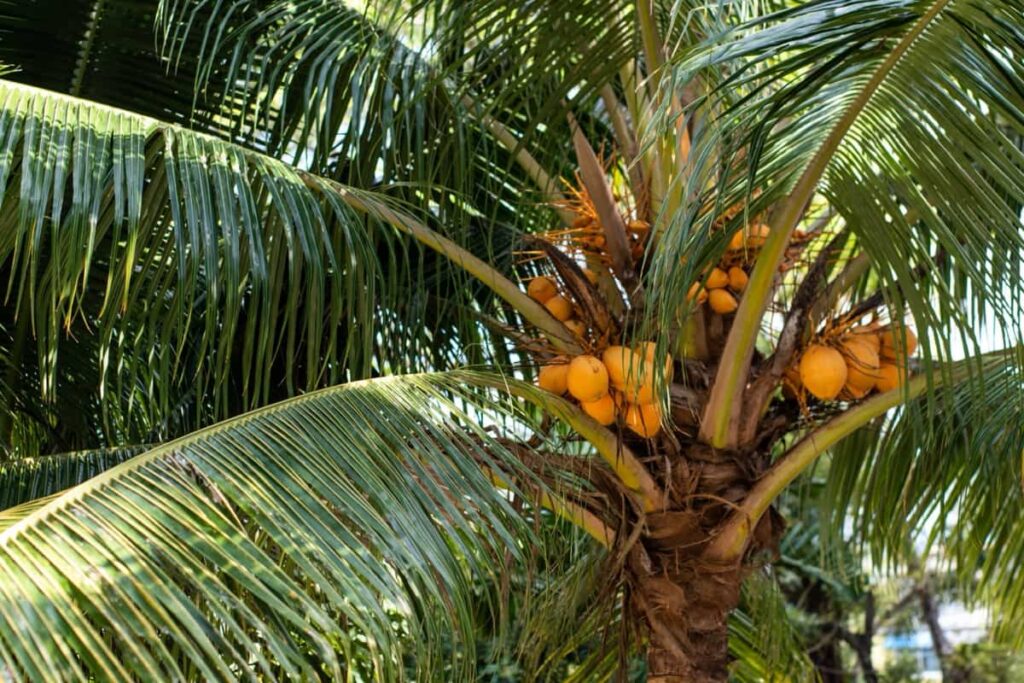
For example, if you plan to plant 500 trees per hectare, this could amount to a total cost of Coconut farming in the Philippines of around ₱25,000 – ₱100,000. Other initial investments include irrigation systems and equipment, such as sprinklers or drip systems, which help ensure proper hydration during dry periods. These costs can add up quickly but are essential for maintaining healthy Coconut trees.
Profit in Coconut Farming in the Philippines
Coconut farming in the Philippines provides a sustainable livelihood for farmers and offers the potential to earn a significant profit. With one hectare of land, Coconut farmers can generate income through selling copra, which is dried Coconut meat used for oil extraction. A typical Coconut farmer can earn around P15,000.00 per month by selling copra. However, it’s important to note that this figure can vary based on market conditions and fluctuations in copra prices. The amount earned ultimately depends on how much the market dictates the price of copra at any given time.
Challenges of Coconut Farming in the Philippines
The major challenge of Coconut farming is the pests and diseases. This pest has caused significant damage to Coconut farms across the country, leading to decreased yields and increased production costs for farmers. Another challenge faced by Coconut farmers is climate change. Rising temperatures and extreme weather events like typhoons threaten Coconut plantations.
These environmental factors can lead to reduced crop yields, tree mortality, and even complete loss of entire farms. Furthermore, there are market-related challenges that impact Coconut farmers’ income potential. Fluctuating copra prices dictated by global supply and demand dynamics can significantly affect profitability. Additionally, competition from substitute products like soybean oil further complicates matters for Filipino Coconut growers.
Frequently Asked Questions About Coconut Farming in the Philippines
How Profitable is Coconut Farming in The Philippines?
Coconut farming in the Philippines has proven to be a highly profitable venture for many farmers. With its tropical climate and vast Coconut plantations, the country is an ideal location for this agricultural endeavor. Furthermore, several government programs and initiatives aim to support Coconut farmers in terms of training, technology transfer, and financial assistance. These resources help improve farm productivity and increase profitability.
What Are the Problems with Coconut Farmers in The Philippines?
The major problem is the unorganized supply chain, making it difficult for farmers to access market opportunities and obtain fair product prices. Without a well-structured supply chain, Coconut farmers are left vulnerable to exploitation by middlemen. Another issue is the vulnerability of Coconut to world price fluctuations. In addition, low farm productivity poses a significant challenge for Coconut farmers in the Philippines.
Where do the Philippines Export Coconut?
The Philippines, known for its lush Coconut plantations, is a major player in the global Coconut oil export market. With an annual export volume of 1.9 metric tons, the country has established itself as one of this versatile oil’s leading producers and exporters. Amongst the top destinations for Philippine Coconut oil exports are the United States and the Netherlands.
Is the Philippines Rich in Coconut Trees?
The Philippines is undeniably rich in Coconut trees, making it one of the top producers of Coconuts worldwide. The country’s tropical climate and fertile soil provide an ideal environment for Coconut cultivation. Coconut farming plays a significant role in the Philippine economy, contributing to domestic consumption and exportation.
In case you missed it: Fruit Yield Per Acre in India: Improve Yielding with These Simple Tips
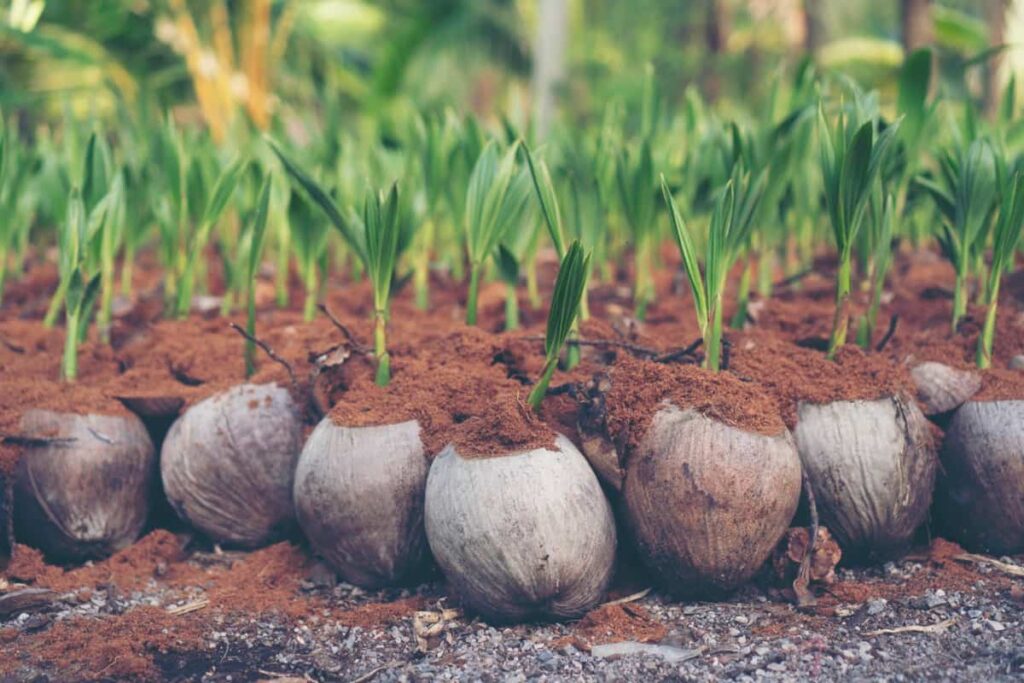
What Is the Best Fertilizer for Coconut Trees in The Philippines?
Selecting the right fertilizer is crucial for promoting healthy growth and maximizing yield. One of the recommended fertilizers for Coconut trees is organic manure. In addition to organic matter, Coconut trees require specific nutrients for optimal growth. These include nitrogen (N), phosphorus (P2O5), and potassium (K2O).
What are the Top Coconut Producing Provinces in The Philippines?
Major Coconut producers in the Philippines include the regions of CALABARZON, Zamboanga Peninsula, Davao, and Northern Mindanao.
How Much Is a Kilo of Copra in The Philippines?
The price per kilogram is around PHP20. Copra, which refers to dried Coconut meat, plays a significant role in the country’s Coconut industry. The price of copra can fluctuate due to supply and demand dynamics, weather conditions, and global market trends.
How Many Coconut Trees Per Hectare Land in The Philippines?
Coconut farming in the Philippines is a widespread and lucrative industry, with farmers strategically planting around 200 Coconut trees per hectare of farmland. This number may vary depending on soil fertility, climate conditions, and farming practices.
What Is the Most Common Coconut Variety in The Philippines?
The Tacunan dwarf Coconut is a highly sought-after Philippine variety that thrives in tropical regions such as the Philippines. Furthermore, this variety has gained popularity not just in local markets but also in international ones.
Steps to Start Coconut Farming in the Philippines
| Steps | Description |
| Coconut Varieties | Tall Dwarf, Laguna Tall, West Coast Tall, Baybay, San Ramon, Tagnanan, Laguna, Agta, etc. |
| Planting Techniques | By germinating seeds or using seedlings from nurseries |
| Nutrient Management | Organic or synthetic fertilizers promote healthy growth. |
| Pest & Disease Management | Effective monitoring methods, along with preventive measures |
| Irrigation & Water Management | Consistent water supply through proper irrigation systems |
| Pruning & Training Practices | Maintain the shape of Coconut trees and promote better growth. |
| Harvesting | Harvest Coconuts when they are about 10-12 months old. |
Conclusion
The Philippines is home to some of the world’s most beautiful and productive Coconut farms, playing a vital role in its economy and agriculture. Coconut farming in the Philippines is a thriving industry with deep roots in the country’s history and culture. With its tropical climate and abundant natural resources, the Philippines has become one of the top producers of Coconuts worldwide.
- Profitable Village Farming Business Ideas in 2024
- High-Yield Aquaculture: Fast-Growing Fish for Farming
- Effective Fish Pond Construction Techniques for Beginners
- Irrigation and Water Management in Pineapple Farming
- Blossom to Harvest: Mastering Flowering and Pollination in Papaya Farming
- Pig Fattening Essentials: From Selection to Sale for Beginners
- Raising Wagyu Cattle: A Complete Guide for Premium Beef Production
- Soil Types and Their Water Holding Capacity
- Optimizing Irrigation Schedules for Coconut Groves for Enhanced Yield
- Espresso Your Garden: Coffee Grounds for Healthier Acid-Loving Plants
- The Best Soil Mix for Snake Plants: How to Mix Your Own Snake Plant Soil
- Green Thumb Success: Expert Tips for Cultivating Greenhouse Beans All Year Round
- Bloom All Year Round: The Ultimate Guide to Indoor Hyacinth Care
- Eco-Friendly Gardening: How to Make Liquid Fertilizer from Kitchen Waste
- Ultimate Guide to Grow Anise in Pots: Explore Seed Propagation to Harvesting
- Guide to Raising Chester White Pigs: Discover Breed Facts to Growth Management
- Mastering the Elegance: The Ultimate Guide to Weeping Cherry Tree Care, Planting, and Maintenance
- Ultimate Guide to Planting Garlic in Grow Bags: Growing Strategies for Beginners
- How to Fix Spider Plant Leaf-Related Problems: Natural and Organic Remedies
- 10 Reasons Why Your Tulsi Plant is Shedding Leaves: Home Remedies and Solutions
- Optimizing Growth and Yield: The Advantages of Palm Bunch Ash Fertilizer
- Utilizing Neem Oil Extract as a Natural Pesticide for Hydrangea
- From Soil to Harvest: Various Ways in Which Farmers Can Use AI Tools
- Steps to Encourage and Induce Citrus Flowers: A Comprehensive Guide
- How to Fix Snake Plant Leaf-Related Issues: Natural and Organic Remedies
- Transform Your Garden into a Fragrant Oasis with Raat Ki Rani (Night Blooming Jasmine)
- Discover the Ideal Chicken Breeds for Philippine Farms
- How to Create a Poultry Egg Farm Business Plan for Profits
- Grow Lemon Cucumbers Like a Pro: Insider Techniques for Bountiful Yields
- Ultimate Guide to Caring for Your Pink Princess Philodendron: Tips for Thriving Variegation
- Areca Nut Profit Per Acre: Calculating Yield and Cost of Cultivation
- How Kaveri Chicken is Becoming a More Profitable Breed in Indian Backyards
- Transform Your Barn: 9 Steps to Convert a Horse Stall into a Chicken Coop
- Exploring Suffolk Sheep Disadvantages with Limitations and Challenges
- Guide to Solving Potted Lemon Tree Problems: How to Revive Lemon Tree in Containers
- Steps to Encourage Female Pumpkin Flowers: Best Strategies for More Flowers and High Yields
